TOPIC: PENTAX CAMERAS
Why the manual step? Upgrading Camera Raw in Photoshop Elements 7
18th January 2010One of the consequences of buying a new camera is that your current photo processing software may not be fully equipped for the job of handling the images that it creates. This especially manifests itself with raw image files; Adobe Photoshop Elements 5 was unable to completely handle DNG files made with my Pentax K10D until I upgraded to version 7.
As things stood, Elements 7 was unable to import CR2 files from my Canon PowerShot G11 into the Organiser, so it was off to the appropriate page on the Adobe website for a Camera Raw updater. Thus, I picked up the latest release of Camera Raw (5.6 at the time of writing) even though it was found in the Elements 8 category (don't be put by this because release notes address the version compatibility question more extensively).
Strangely, the updater doesn't complete everything because you still need to copy Camera Raw.8bi from the zip archive and backup the original. Quite why this couldn't have been more automated, even with user prompts for file names and locations, is beyond me, yet that is how it is. However, once all was in place, CR2 files were handled by Elements without missing a beat.
Canon PowerShot G11 first impressions and initial thoughts
16th January 2010Back in the early days of this blog, I mulled over the idea of having a high-end digital compact camera to complement a DSLR that then was delivering very dusty images; that Canon EOS 10D was cleaned since then and comes in for occasional use to this day. That was nearly three years ago, and a first generation Ricoh GR Digital was the item that then was catching my eye. At the time, I failed to justify spending that much money on such a thing and ended up acquiring a new Pentax K10D DSLR instead. The question that rattled about my head was this: what was the point of spending DSLR money on a compact camera? It is one that never really went away and comes to mind when you see the prices of interchangeable lens compacts like Olympus' Pen and equivalent offerings from Panasonic and Ricoh (there, it's interchangeable lens units rather than actual lenses).
The strongest counterpoint to the cost conundrum is the little matter of size. SLR (film or digital) cameras are sizeable things, and there is a place for having something that drops into a pocket. It is that which has propelled me into taking delivery of a Canon PowerShot G11. It may need a good-sized pocket but, unless you are going out with no jacket, it shouldn't be a problem most of the time. For those shorter sorties when I don't fancy bringing an SLR out, it is well-built and looks the business, though some acclimatisation is to make the best of the knobs, buttons and menus. Nevertheless, the included manual will help with this process (there's a paper quick start guide and more detailed documentation on CD).
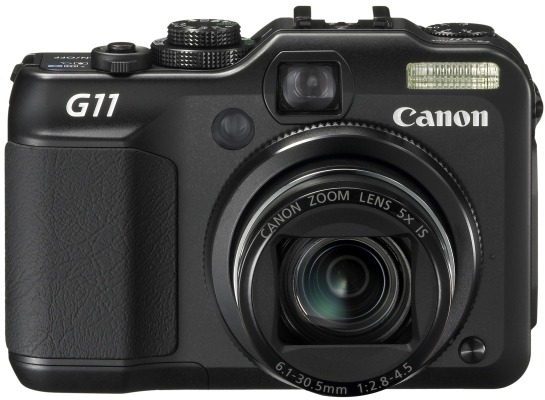
The camera hasn't seen extensive use just yet, so here are a few early impressions. Firstly, there's the matter of size: it's even smaller than the first camera that I ever bought (more than fifteen years ago) and that was a Ricoh 35 mm compact film camera. That comparison is even more striking when you consider the feature sets. The Ricoh was a fixed 35 mm lens affair with things like date and time stamping, ISO choice and a nod towards scenic mode selection. In contrast, the much newer Canon is loaded with the sorts of things that normally are found almost exclusively on SLR's, starting with its effective 28-140 mm focal length range.
Exposure modes such as manual, aperture priority and shutter priority complement scene-based modes and another for movies (not a concern of mine, it has to be said). As if that weren't enough, there's exposure compensation too. It came as a surprise to me to find a form of manual focussing included, though it is not as convenient as turning a focussing ring on a lens. While you can see the inbuilt flash above, there's also a hot shoe and a place to attach a tripod too. Settings like white balance and file format are accessed using the Function/Set button, with the lever underneath the shutter release button controlling the focal length of the lens. In addition, there's also image stabilisation, and that's important when you're using live view to compose a photo. Spot metering and focal point selection are other things that find their way into the package. Some may be excited by other things, but exposure and focussing are essential for any photographic efforts.
An optical viewfinder is included, and it has diopter settings too, but my first impressions are that live view through the rear screen trumps it and I see no need for such things on SLR's. That also flips out from the camera body and can be rotated either for self-portraiture or for folding back in on the camera body for use like a non-articulated screen. Another use is with those occasions when the subject means holding the camera in positions that would be impossible with a conventional screen; holding the camera over your head or down low on the ground are the sorts of situations that come to mind.
Of course, there's more there than those features that I have listed, and the specifications on the Canon website are as good a place to start as any. So far, my only testing has taken the form of cursory checks and to make sure that the thing works properly. Still, this has given me more of a feel for the camera and how it operates. As you'd expect, high ISO settings are noisy, only for a bigger surprise to be that the smallest aperture setting is f/8. Being used to SLR's, I was expecting to get the likes of f/16 on there, but a spot of internet investigation indicated that I should have been taking the size of the sensor into account with my expectations. Any trials so far have been in dull weather, so I'd need to use it in a wider variety of conditions before giving it the sort of wider appraisal that you'd find in the likes of Outdoor Photography (who liked it, it has to be said). For what it's worth, I have found no major criticism so far, though I cannot see it usurping my SLR's not as if that ever was the intention anyway.
An upgrade to Photoshop Elements 8? Not convincing for me...
12th October 2009It now seems that we have a new version of Photoshop Elements from Adobe for every year, unless you're a Mac user. Version 7 convinced me to splash out and that gained me Camera Raw recognition of my Pentax K10D along with subtly enhanced image processing power that I have been putting to good use to get more pleasing results than I ever got before.
What can be achieved by using levels, curves and the shadow/highlight adjustment tool for exposure correction has amazed me recently. Quick selection functionality has allowed me to treat skies differently from everything else in landscape photos, a flexible graduated filter if you like. It seems to work on Windows 7 along with Vista and XP, so I plan to stick with it for a while yet.
As you may have gathered from this, it would take some convincing to make me upgrade and, for me, version 8 doesn't reach that mark. All in all, it appears that it is a way of giving Mac users a new release with added goodness after having to stay with 6 for so long; yes, there are new features like automatic tagging in the image organiser, but they just don't grab me. Given that they already have Aperture from Apple and Windows users seem to get more releases, it's a wonder that any Mac user would toy with Elements anyway. Maybe, that's Adobe's suspicion, too.
Temptations, temptations...
19th August 2009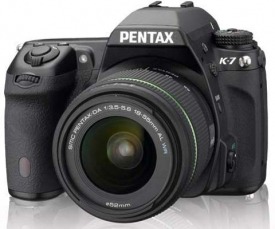
The last time that I went out and bought a new camera was over two years ago, and I am minded not to make another purchase for a while. Apart from damage to the battery cover arising from a fall, my Pentax K10D has survived so far without a problem and I admit to being satisfied with the photos that it makes. Following a professional sensor clean, my Canon EOS 10D has been pressed into service over the past few months, too. Meanwhile, 6 and 10 megapixel sensors generate nowhere near the attention that might have been the case a few years back, but that's by the by. In fact, the megapixel race seems to have stalled, with features like video being added to photographic cameras over the last year and live screens coming to prominence as well. Neither would make me rush out to buy a new DSLR anyway, perhaps because having things the old way suits me just fine and megapixel counts never ever moved me in the first place either.
That's never to say that the likes of Pentax's K-7 or Canon's EOS 50D and 5D Mark II don't capture my attention with their promises of better quality. However, with things the way that they are in the world, I am more likely to retain my cash or maybe invest in new photo processing software for making the most of what I already have. Ideas for photography projects creep into my head when I get to looking over my online photo gallery and realise that not have my tastes changed, while my photographic eye has developed too. That seeing of things in a new light may mean that old subjects get revisited, and I don't need a new camera to do that.
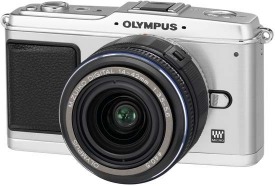
High-end compact cameras such as Canon's G11 and Ricoh's GR Digital III do detain attention for a while but a brief look at their prices proves that you really got to need the portability and I never can justify the outlay when a DSLR will do all that I want from it, and perhaps even for less money. While I admit to pondering the purchase of a GR Digital to cover for the EOS 10D while it was away for cleaning, the Pentax came to be acquired when I realised that the versatility of a DSLR was too much to lose, even for a while. Olympus' E-P1 may have bridged the gap, but the old question of going miniature for the price of a full sized article recurs.
All in all, I am going to stick with what I have right now. We are coming to a time of year when things appear more golden and that combination of lighting and colour are what really matters, not how many megapixels are in your camera sensor unless you are making large prints or supplying stock libraries. As long as my cameras continue to deliver pleasing results, I'll stick with elevating my skills and taking my time over that task, even with all the announcements of new cameras at various exhibitions and shows.
No autofocus?
25th March 2009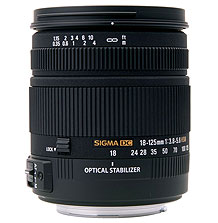
Recently, I recently treated myself to a Sigma 18-125 mm f/3.8-5.6 DC HSM zoom lens for my Pentax K10D. There was a wait for the item to appear, only then for me to find that the lens' autofocus facility wasn't compatible with the body when it arrived. Standard wisdom would have it that I sent the thing back and ask for a replacement or a refund.
Perhaps inexplicably, I did neither. In fact, I came to the conclusion, that since I make photos of landscapes anyway, that been slowed down by the lack of autofocus was no bad thing except perhaps when appealing light makes fleeting appearances. While it is true to say that a used Pentax manual focus lens would have been cheaper, I did what I did.
The camera's autofocus indicator still works and the 18-55 mm zoom that came with the camera wasn't impressive anyway, so taking matters into my own hands was something that happened a lot. Now, I have better quality glass in front of the sensor and with a metal mount and longer range too. The lens comes with a petal hood too, though I keep that for when I really need it rather than keeping it on the lens and stopping myself focussing the thing.
Speaking of zooming and focussing, the controls work well and smoothly without being at all loose. The AF setting gets used to lock the focus and the zoom can be locked at the wide end so that the lens doesn't get into the habit of zooming under the influence of gravity, not a bad thing. For future lens purchases, I might be more inclined to ask about compatibility next time around (I may have been spoiled by the Canons that I used to use) but I remain content for now.
All in all, it feels like a quality item, so it's a pity that Pentax saw fit to make the changes that they made, or that Sigma didn't seem to have kept up with them. Saying that, my photographic subjects usually don't run off so being slowed down is no bad thing at all, especially if it makes me create better photos.
Photoshop Elements 7 first impressions and technical issues
10th November 2008Lately, I have been playing around with Photoshop Elements 7, doing the same sort of things that I have been doing with Elements 5. Reassuringly, I can still find my way around, even if the screen furniture has been moved about a little. My Pentax K10D is recognised, and I am able to set the white balance to get sensible results. On the images that I was testing, things started to look too warm in the Cloudy and Shade settings, but that's all part and parcel of processing photos taken in early November. The results of my exertions look decent enough, and you can see them in a post on my hillwalking blog.
While I realise that Adobe has been promoting the ability to easily airbrush unwanted objects from images and enhance blue skies, there's no point having all of that if functionality available in previous versions does not work as expected. Thankfully, this is largely the case, albeit with a few niggles.
Since I have been working with the new Elements on a Windows XP SP3 virtual machine running in VirtualBox 2.04 on Ubuntu 8.10, I wonder if that contributed in any way to what I encountered. One gigabyte of memory is allocated to the VM. The files were stored in the Ubuntu file system and accessed using VirtualBox's functionality for connecting through to the host file system. File access was fine, apart from the inability to directly open a file for full editing from the Organiser, something that I have doing very happily with Elements 5.
In addition, I noted a certain instability in the application and using the hand tool to get to the top left-hand corner of an image sent the thing into a loop, again something that Elements 5 never does. Otherwise, things work as they should, even if I saw points to the need for an update to correct any glitches like these, and I hope that there is one. For now, I will persevere and see if I can make use of any additional functionality along the way.
Another avalanche of new DSLR’s…
24th January 2008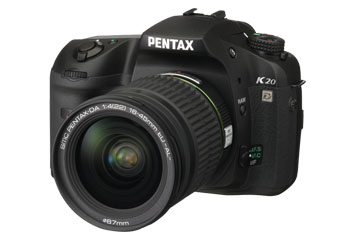
A flurry of new DSLR announcements came out today; they seem to come in droves when they do arrive, but I reckon that upcoming photography shows might have something to do with it. Canon replaced its entry-level offering with the 12.2 megapixel EOS 450D. Yes, I know that megapixels aren't everything, yet a goodly number does make a rather good impression and Canon's range looks a bit lop-sided again with the entry level DSLR on the surface of it having the potential for recording more detail than the next one up in their range, the EOS 40D. It almost seems that it would have been more sensible to delay the arrival of that camera until after the 450D and give enthusiasts a really impressive option.
As it stands, they might end up playing into the hands of Nikon with its D300, a strong contender if I were in the market looking for a DSLR. Pentax displays no such idiosyncrasies with its 10.2 megapixel K200D and its 14.6 megapixel K20D, while Samsung has also presented their variant of the latter: the GX200. It will be interesting to see reports of how all of these new arrivals perform. Launches like this do not take long to make your once shiny acquisitions look dated, and that fate certainly seems to have befallen my K10D. For some reason, that reminds me that my trusty old EOS 10D needs to be sent away for cleaning, a job that has been on the to-do list for a while.
More digital than film?
26th October 2007Despite the rampant progress of digital photography, I have continued to stick with film and sit astride the fence. While that is something that I wish to continue, my most recent trips into the outdoors have seen me use my Pentax K10D exclusively. That, however, could be something to do with the subject matter.
My most recent trot took me into what might be described as featureless moorland, a tricky subject to capture in the best way. So, possibly because of the lesser likelihood of success, I stuck with digital since any lack of success costs less. Previous trips took me out and about locally where I live and where I seem more likely to use digital, possibly because I have been around the area a lot with my film camera anyway. Also, the vistas, as pleasant as they are, do not possess the drama of the likes of Highland Scotland, the English Lake District, or the mountainous parts of North Wales.
Field testing my new Pentax K10D while out hillwalking
24th July 2007On Saturday, I happened to be in a branch of Jessops only to overhear a salesman emphatically state that you don't buy a camera for its specifications but for the photos that it produces. While his tone of voice was a touch condescending, and he seemed to be putting down a DSLR, he was essentially right. Nevertheless, the specifications do help you get the images, so they have to be seen in that light.
For instance, having on-board sensor cleaning may save you from having either to clean the thing yourself or send the camera away for the professionals to do what is needed, a much safer option in my view. And there may be occasions where image stabilisation is very useful, low light wildlife photography for instance. Yes, there are features that I consider surplus to requirements, like live viewing and movie capture, and that is very much due to my buying cameras to make photos. The salesman in question would surely have agreed...
Off to the Lakeland Fells
Sunday saw me head to the Lakeland Fells for some walking and a spot of testing of my new Pentax K10D. The details of the walk itself are not for here but for my hillwalking blog and that is where you will find them. While making my way from Crewe to Windermere, I perused the manual looking particularly for information pertaining to functions that I actually use, I should really have done this beforehand, but distractions meant that I hadn't got around to it. I had to wade through something designed for a new SLR user before I got to what I consider the important stuff. Though this may be a bit irritating, I can understand and accept why they do it this way; we were all new users once, and they are hardly likely to want to know about things like aperture priority, raw file capture, ISO control and such like straight away.
First Impressions of the Pentax K10D
What do I think of it then? Let's start with first impressions. It is definitely smaller than the Canon EOS 10D it accompanies in my possession. That said, it is not too small and there is a decent grip hosting the shutter release button and the camera on/off switch. It also feels well-assembled and reassuringly weighty, an important consideration given that it will see the outdoors a lot. A discussion of the features most relevant to me follows.
Power Management and Response Time
On the subject of switching on and off, the camera is set to go into a sleep mode after a second of inactivity, but it reawakens quickly when needed, the trigger being half-depression of the shutter release button. In fact, the camera does reawaken much faster than my Canon as it happens and where the delay is a constant source of some irritation.
Key Controls and Features
Even if it might sound strange, the on/off switch is also used to activate the depth of field preview, something that no SLR should not have. The location may be unusual, but maybe the designers thought that having shutter release and depth of field preview next to each was a logical way to do it. From a camera operation point of view, there is certainly something to that way of thinking.
Behind the shutter release, you'll find a screen that is a reminder of film SLR's. This conveys information such as battery life, number of exposures remaining on the card and exposure details (aperture & shutter speed).
Display and Menu System
Staying on the subject of screens, the one on the back of the camera is larger than that on the Canon. As is customary for these, it allows replay of photos taken and access to the various menus required to control the camera's operation. In comparison to the Canon, which is essentially a one menu affair with a thumb wheel controlling scrolling and an OK button at its centre to perform operations, the Pentax has a more elaborate system of submenus: one each for recording, playback and set-up.
The playback menu is where I found the setting that makes the camera highlight areas of underexposure and overexposure during image playback. This is something that I missed regarding the Canon until I happened upon it. Camera cleaning is located on the set-up menu, and the camera is now set to clean the sensor every time that it is turned on. Why this is not enabled by default is a little beyond me, but the designers might have thought that a vibration from the camera on turning it on could have resulted in a load of support calls. The same submenu also hosts memory card formatting.
File Format and Navigation Options
The recording submenu is where I set the camera to deliver RAW DNG files, an Adobe innovation, rather than the default JPEG's. There are other options like RAW PEF files, Pentax's own format, or RAW and JPEG simultaneously, but my choice reflects my workflow in Photoshop Elements; I have yet to stop the said software editing the DNG files, however.
With all these options, it is fortunate that there is a navigation wheel whose operation uses arrow buttons to get about. While on the subject of the back screen, there are further settings that are accessed with the FN button rather than the Menu one. These include ISO, white balance, shooting mode (single, continuous, timed and so on) and flash. The only setting that I changed out of this lot was to set the ISO to 400; I prefer to feel that I am in control.
Exposure Modes and Controls
Returning to the camera's top plate, the exposure mode dial is on the left-hand side, which is no hardship to me as this is in the same place as on the Canon. There are no scene modes, but the available exposure modes are more than sufficient: fully automatic, program, sensitivity priority, shutter priority, aperture priority, shutter and aperture priority, manual, bulb and external flash synchronisation.
A few of these need a spot of explaining. Sensitivity priority is a new one on me, but it is a consequence of the ability of DSLR's to offer a range of ISO settings; the aperture and the shutter speed are varied according to the ISO setting. Shutter and aperture priority is like manual exposure and is the inverse of sensitivity priority: set both aperture and shutter speed, and the camera will vary the ISO setting. Both of the foregoing assume that you let the camera set the ISO, but my setting the thing myself may have put paid to these functions.
Shutter priority and aperture priority are, as far as I can tell, their usual selves. For all exposure modes, the thumb wheels at the front and back of the shutter release handgrip set apertures and shutter speeds where appropriate, and this arrangement works well.
Metering Options
The focussing mode selector is found on the left of the body, next to the lens coupling. I am used to having this on the lenses themselves, so this is a new arrangement for me and one to which I can easily become accustomed. In fact, it is easy to find it while composing a picture. The modes themselves are manual focus, one-time autofocus and continuous autofocus; the last of these is for focussing on moving objects.
While I could go further, perhaps overboard, with a discussion of the features of this camera, I draw a line at what's here. Yes, it is useful to set the focussing point and activate image stabilisation, but the above are what matter to me and its performance in the photo making department is the most important aspect.
Performance in the Field
That neatly brings me to my appraisal of how it performs. With inspection of the first few images on the review screen, I was a little disappointed to see how dark the foreground was in comparison to the sky. When I brought everything home, as I always do, I found that things weren't necessarily as they appeared in the field. The Pentax more usefully offers histogram review and highlighting of any areas that are either underexposed or overexposed. It is these functions that I will be using in reshooting decisions while out and about with the Pentax, and the same can be said for how I currently use the Canon.
In fast changing lighting, the AE lock technique was a bit irritating, yet I am certain that I will get better at it. The autofocus doesn't always lock onto the subject, especially in tricky lighting, so manual focussing is a definite necessity and is more useful more for landscape photography, in fact. Nevertheless, the autofocus did do well most of the time, and my Sigma lenses have done worse things on me.
Conclusion
Overall, I'm satisfied with the K10D and plan to continue using it. My recent excursion yielded some quality photographs, which, as the Jessops salesperson would agree, is the ultimate purpose of any camera.
What Amateur Photographer recently reviewed
19th July 2007Amateur Photographer seems to have had a run of reviews recently. First off were the Olympus E-410 and E-510 that they seemed to like. Then, they moved onto the Ricoh Caplio GX100, which they seemed to like that too, though they did say that the quality wasn't up to SLR standards. But then again, it is a compact and that might be expecting a bit too much.
This week, Paint Shop Pro comes under the spotlight, as does Epson's V350 scanner. While I have yet to read these, I have been engaging in a spot of equipment acquisition anyway. My CanoScan 5000F scanner has been usurped by Epson's Perfection Photo 4490 and delighted I am with it too. The quality of the scans that I have been doing of prints has been good, and the presence of an on/off switch is a creditable one. When none of the other scanners that I have had possessed it, having to plug something in and out from the power socket is inconvenient to say the least.
In addition, I have also gone and got myself a new DSLR. Seeing Pentax's K10D going with an 18-55 mm lens for £499 at Jessop's overrode my better reasoning, putting paid to ideas of purchasing any other electronic goods for the rest of this year. It's an award-winning gadget, and Photography Monthly's Will Cheung seemed to get on fine with it. While Which Digital Camera said it was heavy, it has to stand up to use in the great outdoors.
Though the sensor may be a 10 megapixel affair, this will be an upgrade to my Canon EOS 10D; that has a sensor in need of clean right now (I plan to get it done by the professionals) and every time that I want to use an image that it has made, Photoshop's healing brush has to be pressed into service. Pentax does boast about all the seals that it has added to the K10D, a good thing if they cut down on the dust entering the camera. And if dust does get in, the sensor cleaning feature will hopefully see it off from the photos.
Image stabilisation, another value adding feature, is also there and may prove interesting. Strangely, there's some video capture as well, and I hope that it doesn't get the EU coming after me to collect retrospective camcorder duty. In any case, it's not a feature that I really need, with the Live View functions on the equivalent Olympus offerings falling into the same category. It'll be interesting to see how the K10D performs, given that it's a change from the Canon/Nikon hegemony that seems to dominate digital photography these days.
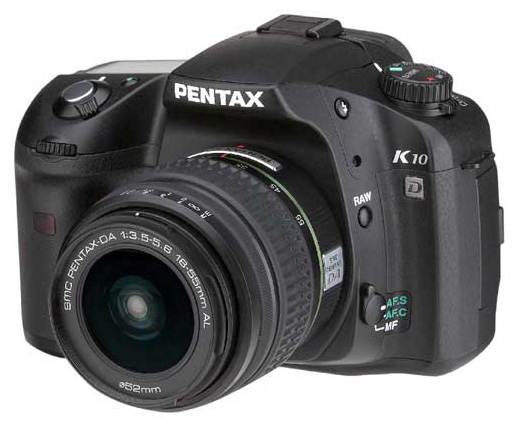
Update: I have since perused the current issue of Amateur Photographer and seen that Paint Shop Pro suffered from performance issues on computers that worked fine with Photoshop. Otherwise, it compared well with Adobe's offerings, even if the interface wasn't seen to be as slick. Epson's V350 was well received, though it was apparent that spending more got you a better scanner; that's always the way with these things.